6. BioFabricating Materials¶
Welcome to the week of unexpected results, colours and textures! rajouter la quote

Cecilia setted the tone : there is no mistake, only experimenttaions and fun. Thanks for this super cool quote which gave us so much freedoom :)
Biomaterials Pionners¶

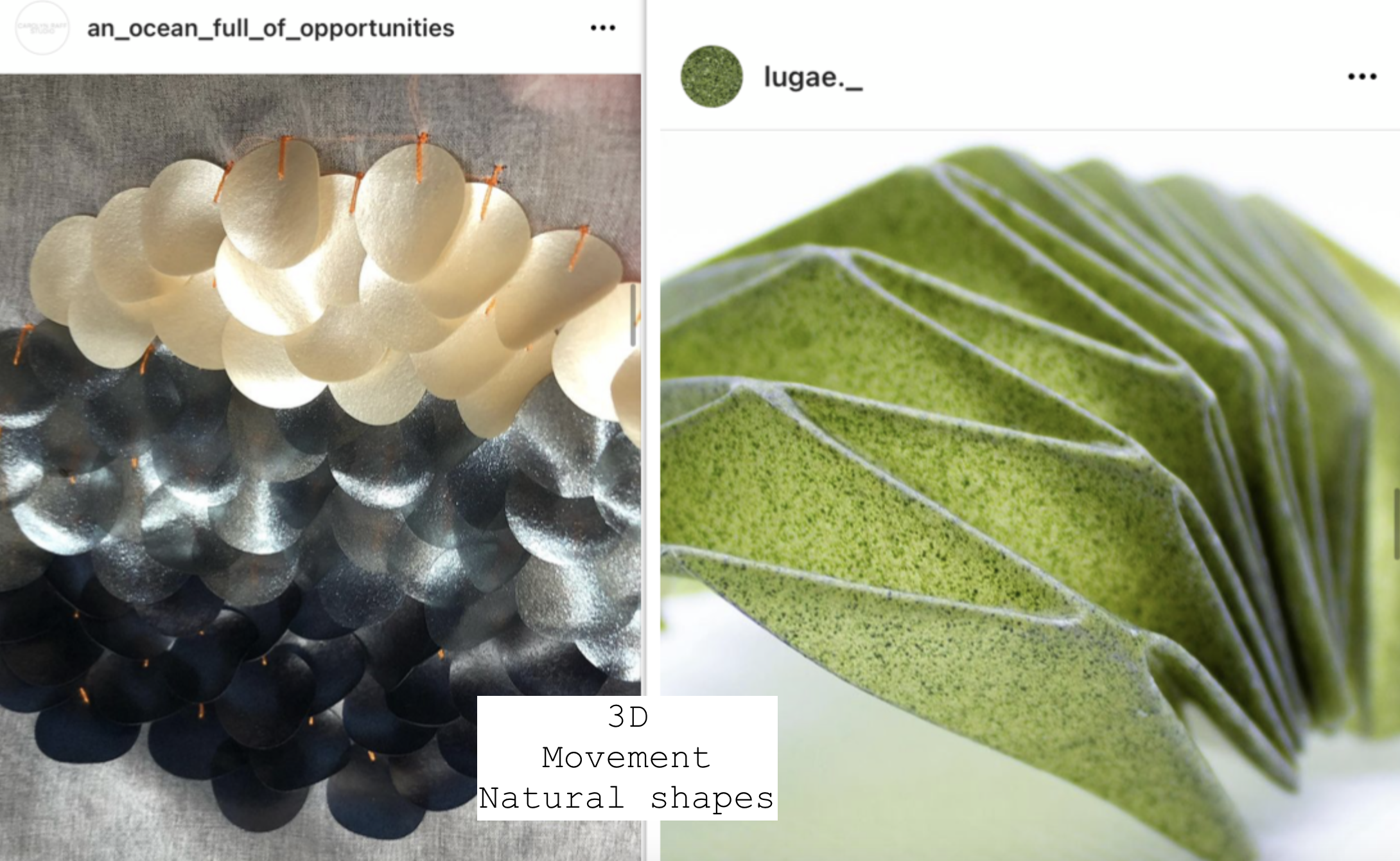
An Ocean full of Opportunities
Personal ideas¶
One years ago, during pandemic, I developped an idealist project with a 100% biodegradable product.




This is a primary research and I see that there are many possibilities to achieve it thanks to pionners' experimentations. It might be a direction for my final project......
Bio Experimenations¶
Agar agar recipes¶
- Agar agar with red cabbage
from CookBook

| Ingredients and Quantities
| Agar : 5gr
| Glycerol : 15gr
| Water : 100mL of water and 150mL of red cabbage ink bath
Cook +/- 25 minutes at 80°C gives the best results
- Bio Plastic 1
From Bio-fabricating materials

Ingredients and Quantities
Agar : 4g
Glycerine : 25g
Water : 400ml
Warm up the water (max 80°C, 60°C is better), add glycerine, add agar. Mix until smooth. Simmer for 30 minutes, slowly move to 86°C max. It should have a honey texture. Poor in a mold.
- Bio Plastic 2
From Bio-fabricating materials

Ingredients and Quantities
Agar : 4g
Glycerine : 17mL
Water : 200mL
Warm up the water (max 80°C, 60°C is better), add glycerine, add agar. Mix until smooth. Simmer for 15 minutes at 80°C, slowly move to 86°C max. Poor in a mold.
- Conductive Bio Plactics 1
From Elisabeth Lorenzi Materiom

Ingredients and Quantities
Agar : 2gr
Glycerol : 1mL
Salt : 5gr
Water : 240mL
Add agar with water and glycerine. Heat the mixture to 95°C or to just below boiling point. Keep stirring for a while. Allow the mixture to become some degrees cooler before putting it in a mold. It will get solid when it gets cool. It will take a few days to dry.
- Conductive Bio Plactics 2
From Elisabeth Lorenzi Materiom
Ingredients and Quantities
Agar : 4gr
Glycerin : 12gr
Salt : 10gr
Water : 800mL*
*misread the cardboard and put 800mL instead of 200mL but it is drying well so far
These conductive bioplastics seem long to dry, maybe because of the salt which aborbs water.
- Flexible bio-foil
From Bio-fabricating materials
Ingredients and Quantities
Agar : 5g
Glycerine : 15g
Water : 250mL
Cook +/- 25 minutes at 80°C gives the best results
- Stretch bio-foil

Ingredients and Quantities
Agar : 3g
Gelatine : 20g
Glycerine : 15mL
Water : 400mL
Cook +/- 45minutes at 80°C gives the best results
Alginate recipes¶
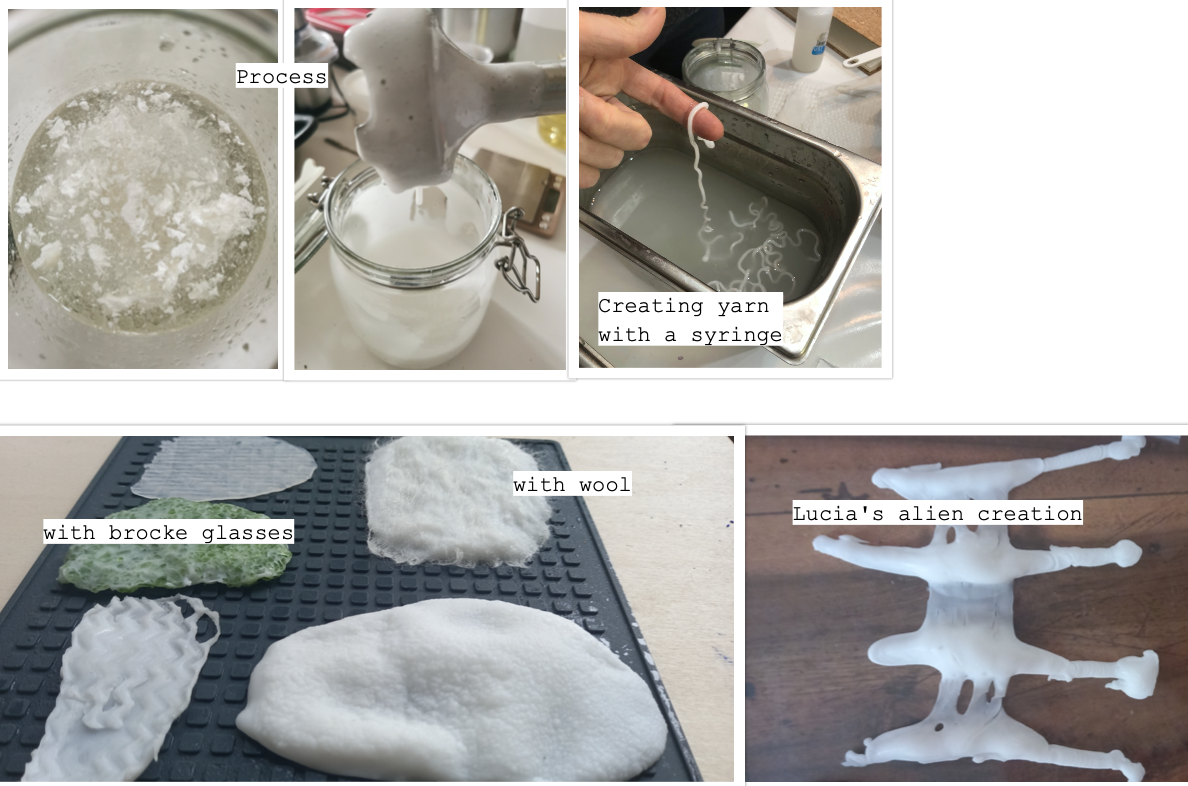
- Flexible thin BIO-PLASTIC
Ingredients and Quantities
Alginate : 12gr
Glycerine : 20gr
Sunflower oil : 10gr
Water: 200ml
- Spread solution for curing
Ingredients and Quantities
Sodium chloride hydrate/ Calcium Chlorure : 10ml
Water : 100mL
Gelatine recipes¶
Bio Resin, Bio Plastic and Bio Silicone use the same ingredients (Gelatin, Glycerin, Water),
the difference is in the amount of Glycerine added.
- Bio-resine

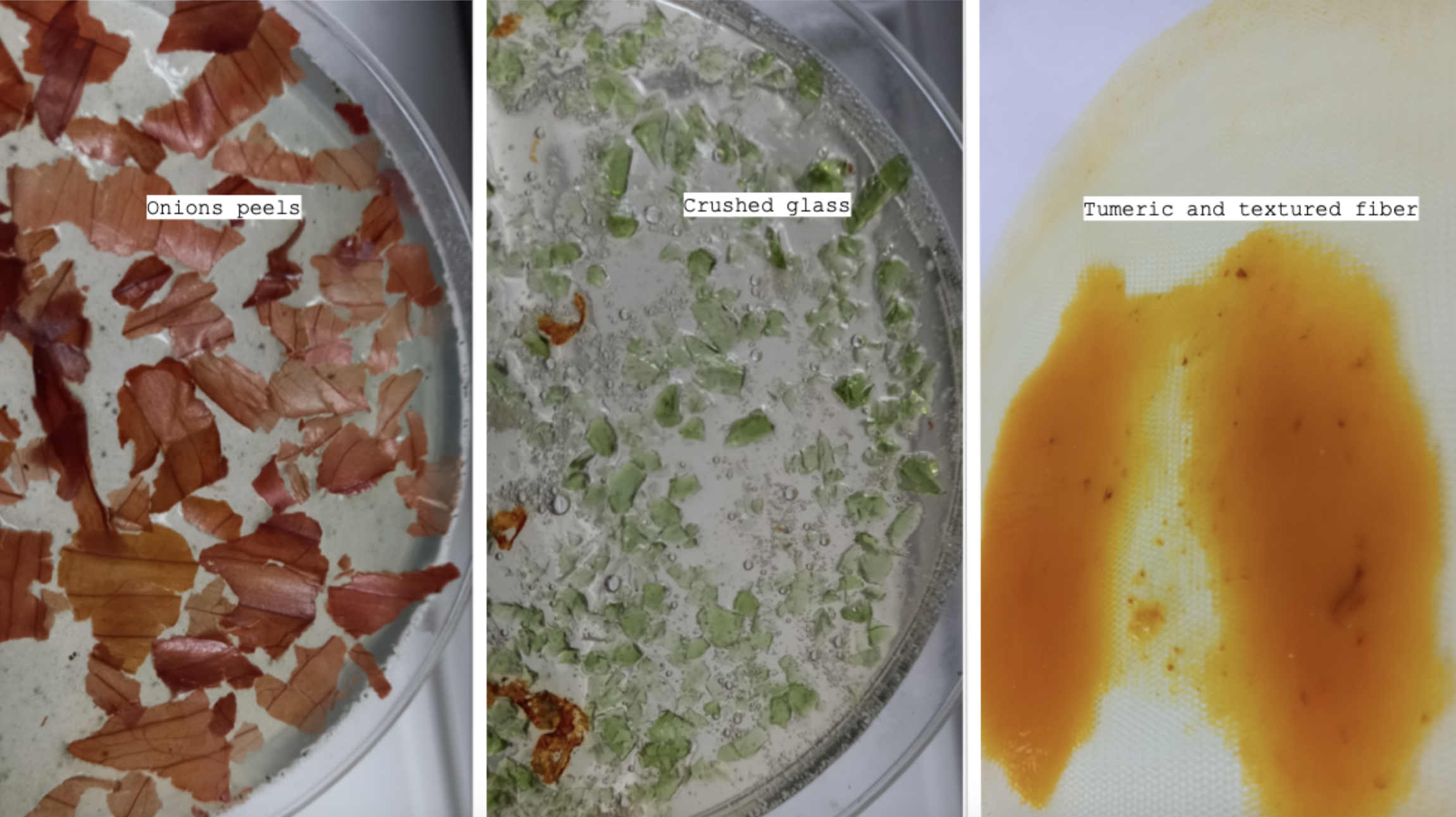
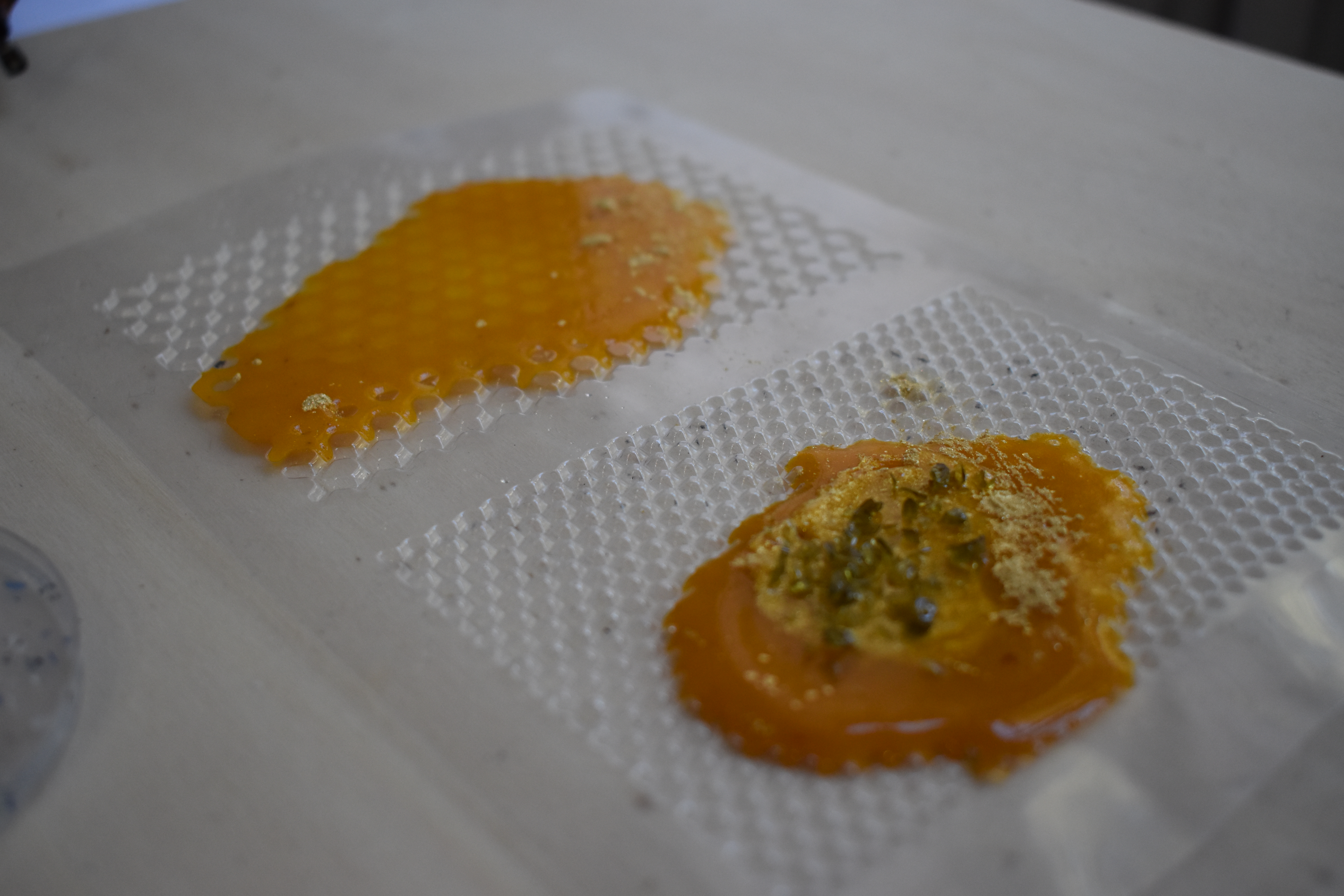
Ingredients and Quantities
Gelatine : 48g
Glycerin : 8g
Water : 240mL
This mixture should be completely dissolved at a temperature of 60 degrees, then let it reach 100 degrees and cook for 5 - 10 minutes. The longer it cooks the harder and more brittle it gets.
- Bio-silicone
![]()
Ingredients and Quantities
48 gr of Gelatin
24-48 gr of Glycerin
240 ml of water
This mixture should be completely dissolved at a temperature of 60 degrees, then let it reach
100 degrees and cook for 5 - 10 minutes. Glycerine can be added up to 1:1, that is to say 48 gr
of Gelatin and 48 gr of Glycerin. The more Glycerin the more flexible it will be.
- Bio-plastic
Ingredients and Quantities
48 gr of Gelatin
12 gr of Glycerin
240 ml of water
This mixture should be completely dissolved at a temperature of 60 degrees, then let it reach
100 degrees and cook for 5 - 10 minutes. The longer it cooks the harder and more brittle it gets.
- Brittle Gelatine + Clay

Ingredients and Quantities
Gelatine : 24g
Glycerin : 0g
Water : 120mL
Clay : 10g
- Bio-foam

Ingredients and Quantities
Gelatine : 48g
Glycerin : 12g
Water : 240mL
Soap* : 10mL
*liquid soap (blue one) gives a better result than glitters soap(pink one) → more bubbles
Zuku recipe¶
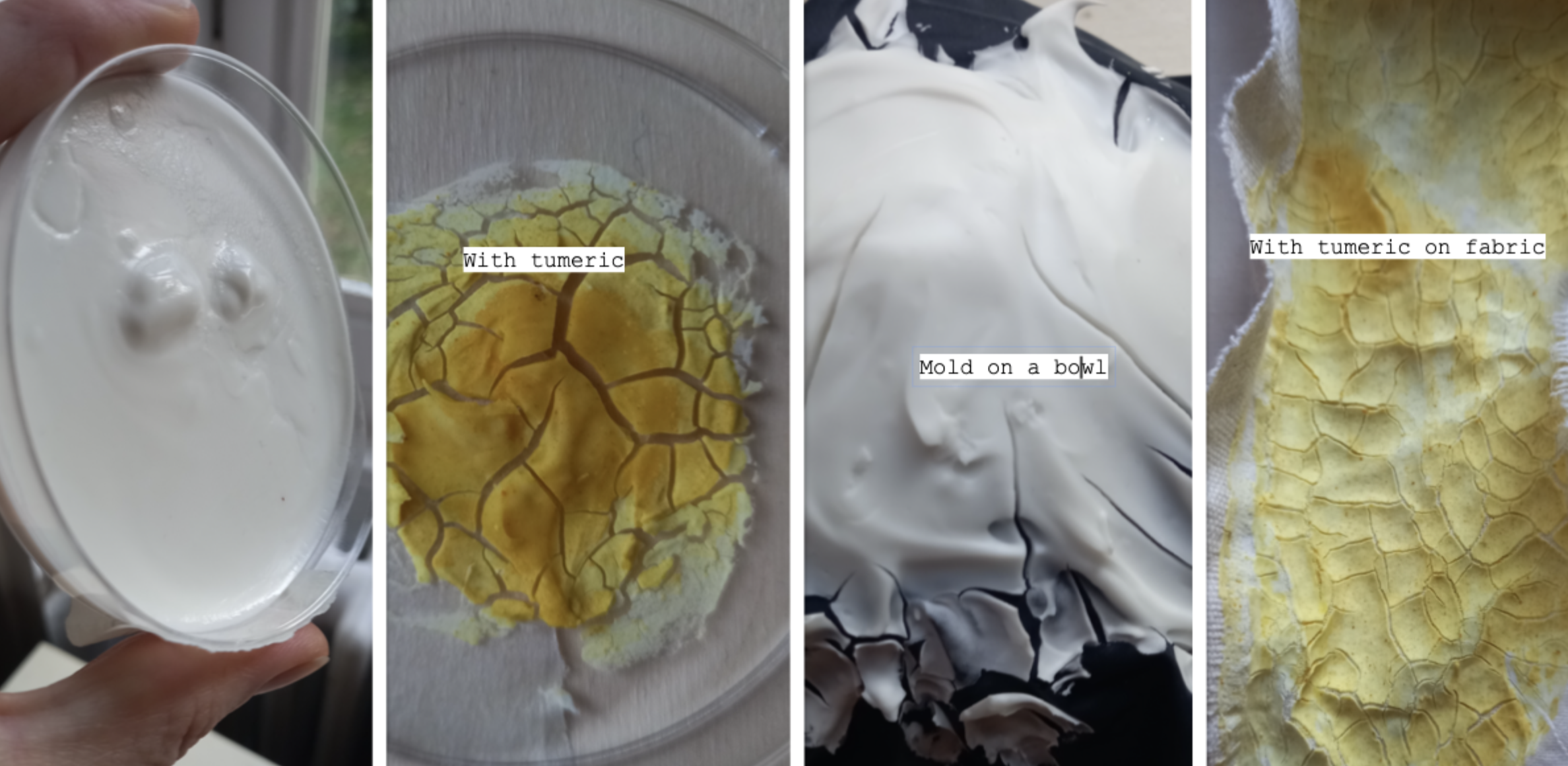
Ingredients and Quantities
Kuzu : 60 mg
Water : 120 ml
Glycerine : 10 mL
Vinegar : 10 mL
*The recipe we followed was taken on From Materiom from a tapioca starch recipe
Take a cooking pot (preferably steel container). Add kuzu and coldwater and stir until no lumps are present and kuzu is completely dissolved. Add glycerine and vinegar to the kuzu solution and mix well. Now, cook the solution under a low flame for five minutes, keep stirring (the whisk was a good toll for this step) the solution until it becomes a thick white paste. Transfer the compound from the cooking pot and spread it over a butter/ oil coated flat surface.
RESULTS¶

Those are some results of our bio experiences.... but most of them were rotten because of humidity of the lab! But it was still beautiful and experimental :)
Pauline's Mycelium¶
Pauline found this tupperware in her kitchen which was there for months..... And she had that great idea to keep it for biomaterial week :)
We will see the result after she put it in her oven. So exited to discover the cooked mycelium.....

After weeks, the mycelium died unfortunately, there was no more life so Pauline threw it away :(
Kombucha Part 1¶
To be ready for the week of biomaterials, we started our Kombucha.
We used a classical recipe with black tea to start with and later on we might make other recipes.
So here is the recipe:
For 1L of water :
-
1,5 to 3 gr of tea ( we used black tea,but it can be any tea, depending what color of material you want)
-
100 gr. of sugar
-
Vinegar from 0 to 100ml (depending on PH of your liquid)
-
Scoby mother
In our case as we want a little bigger of a piece of Kombucha material, so we made 7 L of water.
For 7L of water :
-
21 gr of black tea (+ filter bag or tissu)
-
700 gr of sugar
-
Vinegar - we added around 100 ml of vinegar untill it got to PH 3
-
Scoby mother - 15cm ø
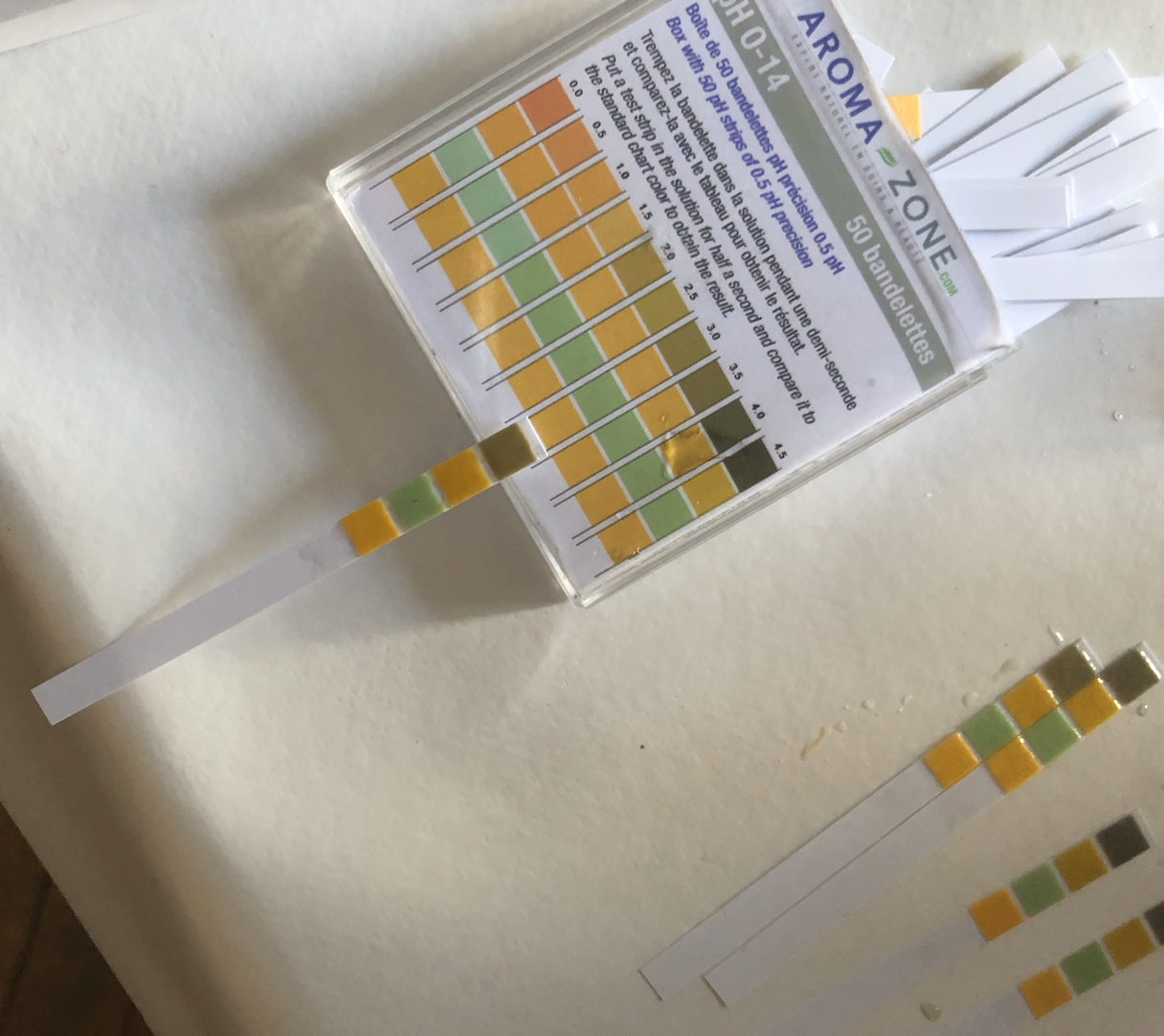
STEPS :
-
Prepare all the ingredients, tools, utensils that you need at your workspace.
-
First we sterilise our equipment, especially the tray where you gonna grow your material and make sure that all is clean as Kombucha can get contaminated by various microorganisms around us.
-
We boil water in a pot and add tea into it and keep boiling a bit, in our case we didn't have extra pots, so we added boiling water directly in a plastic tray and then we added tea in a coffee filter bag closed with a thread that leaves don't go all over.
-
And then we add sugar and mix it well until it dissolves, the best to do is to add it while its hot, it will work better.
-
Now its time to let it cool down until room temperature, for us it took almost 2 hours for 7L of water. If we add Scoby into hot liquid it will most likely kill it, so we better wait.
-
When our liquid has reached the room temperature we meausure the PH with PH strips or PH meter, french tap water meauseres around PH 7. So we added around 100 ml of Vinegar until it got to PH 3.
-
And now when we set up good sweet, acicid conditions we can add our Mother Scoby, make sure you do it with gloves or desinfected hands.
-
We cover it with thin breatable cotton fabric that insects and dust can't get in, put elastic around that its well covered and can be easily open for our weekly check-ups.
-
Place it in a warm (ideally 30' degrees Celsium) temperature, we put it on a specail matrass for germination of seeds. The speed of growth depends on the temperature of the ambiance.
-
And the last important thing - don't move the tray while the Kombucha is growing, keep it in a dedicated place. The desired Kombucha material will appear in about few days - week as a thin layer. The second part of the Kombucha travel will be later on the Biomaterials week.
Kombucha part 2 recipe¶

-
After few weeks depending on your environment the Kombucha will start growing. In our case after 2 weeks it grew up to 1 cm, so we can wait 1 more week. What is the next procedure when we achieve the desired thickness? (Keep in mind that 1 cm of Kombucha will turn into almost 1mm after drying.)
-
When Kombucha reached about 1,5 cm (or less or more, depending on your needs) we can take it out with clean medical gloves. We wash it in soapy water to wash away the sticky sugary part and then we rince it in clear water. Now its the creative part - we can dry it on a flat surface or textured or even a specific form as Kombucha will take the form of the surface on which it is drying on. Of course the best if we could turn it every day or few days that it dries equally or to have a breathbale surface, but you can test it around.
-
And the liquid where the Kombucha was growing can be reused now to make more Kombucha, but we need to add sugar and tea accordingly. Always make sure that you keep all clean disinfecting to not contaminate Kombucha growth.
-
The Kombucha leather will be ready in about 1 week depending again on your environment.
Useful links / references¶
- Mycocomposite Workshop by Jessica Dias
- Tutorial Biomaterials Part 1 by Beatriz
- Tutorial Biomaterials Part 2 by Beatriz
- Material driven
- Bio Fabricating Materials by Cecilia
- Amanda Jarvis profil
- 3BIO BIOMATERIAUX
- Remix el barrio
-
Meet with Siddhant malviya : doing biogarments and design researcher at Saint-Etienne
Key words of the week/reflexion¶
This week was cool because we made so many experiences, colours, textures and shapes. That I went at Art Museum in Lyon to see the exhibition about ceramic and colours aha but I was a little dissapointed because there were only a few creations.
I also went to the exhibition about Sioux... It was incredible! I really recommanded it!